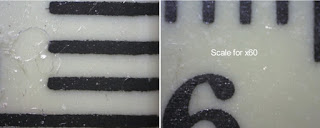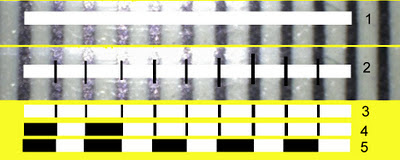I have a new plaything, a Samsung Galaxy tablet. I bought it in New Zealand and originally needed it mainly to read a large pdf file in a hurry, and also to read many, many old books about the gold rush era, that being for the next book, but I am finding all sorts of other uses for my new toy. That said, one small part of me has been dwelling on the word tablet.
When I was eleven, the educational authorities judged me ripe to have Latin and French instilled by dull sadists with no idea of making the study interesting. I rote-learned '
La plume de ma tante est sur la table', and '
mensa, mensa, mensam, mensae, mensae, mensa', which we were told was declining
mensa, a table in Latin.
It struck me as curious that French and English had the same word for table, while the Romans had a different word. That led me to wonder about times tables, and so began my career as a marcher to the beat of a different drummer (or sometimes several different drummers at once). My musings were more interesting than the rote learning that was foisted upon us—not in itself, praise for my musings, save as a contrast to the drear that was foisted upon us. I upheld my end of the struggle, and remained true to my curiosities, which is why I came of my tablet with a slightly different set of thoughts to others.
You see, by then, I knew a thing or two about that curious word "table" and its diminutive form "tablet", because I had been gathering data in the highways now and then, but mainly in the byways. Among other things, I found that the Romans also had a similar word,
tabula, meaning a board or plank, but by then the juggernaut of my curiosity was moving, so I kept pursuing the meanings of 'table'.
I learned that in the mid-1200s, Alfonso X, Alfonso the Wise of Castile, caused a set of astronomical tables that we now call the Alfonsine Tables, to be published in Toledo, which is why they were sometimes also called 'Toledan tables'. In 1620, a Swiss watchmaker, Joost Bürgi, published his
Arithmetische und geometrische Progress-Tabulen, a set of logarithmic tables, and in 1627, Johann Kepler published a set of logarithms in the
Tabulae Rudolphinae, which commemorated his patron Rudolph II, Emperor of Austria, and King of Bohemia.
Those examples aside, most tables in Europe up until the 1600s, and even for quite a long while after it, were tables that you could eat at, or turn on an opponent — or you could drink people under them, but these were all tables with legs, and unless those sitting at them were bent on a bit of graffiti work with their daggers, there would be precious little recorded on those tables.
Yet at some point, the flat slab sort of table became, at least for mathematicians, first and foremost a collection of figures, displayed in a regular grid. Later, we came to have contents tables, mathematical tables, data tables and tabulation, and even the tab key on our computers, which had been used in setting up tables on the typewriters that gave us our computer keyboard. This then, is an exploration of tables and how they came to have their modern meanings.
In the Middle Ages and before, the table was more than just a place to eat: it was a place of great social occasion. Chaucer tells us that the squire in the Canterbury Tales was a fine young man:
Curteis he was, lowely, and servysable,
And carf biforn his fader at the table.
Here, Chaucer reflects on the way that a table you sat at for eating, and where you sat at it in the Middle Ages, was also a sign of rank, a bit of a league table, you might say. The fact that the squire sat at the same table as his father, the knight of the
Tales, and carved for him, defines him as holding high rank. This follows a comment about the knight himself, earlier in the
General Prologue:
Ful often tyme he had the bord bigonne
Aboven alle nacions in Pruce
In other words, the knight sat at the head of the table, or board, in Prussia, where knights of many nations gathered to help the Teutonic Knights war against their heathen neighbours in Lithuania. So in Chaucer's time, there was no real distinction between a board and a table, but there was a distinction about where you sat at the table. This distinction is still preserved today in places where honoured guests are seated at the High Table, while other common folk are allocated positions below the salt.
In the
Summoner's Tale, we hear of a friar who would beg for food:
A peyre of tables al of yvory,
And a poyntel polysshed fetisly,
And wroot the names alwey, as he stood,
Of alle folk that yaf him any good.
But once he was out of their sight,
He planed away the names everichon
That he biforn had written in his tables
The dirty dog!
While these tables that the friar used were associated with food in a way, they were small enough to carry around. In fact, they were wax-coated ivory tablets, on which he scribed with a carefully pointed stylus (the poyntel), but then as soon as he was out of sight, with a quick wipe, he flattened the surface, ready to start a new sucker list on what the Romans would have called a
tabula rasa, a clean table (in the sense of a plank or board). The Romans were rather keen on using tables to display things, and these were often slabs of marble, on which important things were carved. Their Twelve Tables enshrined the basis of Roman law, and when Cicero was a boy, he was required to learn these by heart. Moses is usually depicted as coming off Mount Sinai with the Ten Commandments on two tablets of stone.
So this type of table was often a tablet, more like the 'table book' that Shakespeare has Nathaniel use in
Love's Labours Lost than any item of furniture (or medication). We still call a notepad (the non-computer sort) a 'writing tablet' today, occasionally, but a table is more commonly a flat slab with legs, used for sitting at, or perhaps it is used for a governing council of some sort, though we still speak always of a board of directors, even if they sit at a 'board table'. Documents drawn to the attention of those present are tabled, meaning they are placed on an item of furniture.
Shakespeare uses both 'board' and 'table', in roughly equal proportions to indicate an eating place, but he refers in his sonnets and elsewhere to the tables of the heart, apparently meaning something like loving memory, something that could be written on like a writing tablet, but this leaves open the question of how we came to have other sorts of tables.
The original table was a flat slab or board, that might be thrown across trestles to make the furniture sort of table, but they could also be used to inscribe rules, laws and commandments, and both these meanings apply to the Old English
tabule, but the mathematical use appears to come from astronomy. In the
Franklin's Tale, Chaucer writes of Aurelius bringing forth his "tables Tolletanes", his Toledan astronomical tables, and Chaucer notes that they were "ful wel corrected", so the tables were written on something correctable.
Could it be that astrologers and such carried these tables around on slabs, or maybe even on wax-coated ivory tablets like those of the Summoner? This was before the start of printing, and so it is at least possible. After all, astronomers, long after that time, recorded their results on planks of timber, which were sometimes, in some contexts, referred to as tables, at least in a figurative sense. In 1390, John Gower wrote "
He broghte him sauf upon a table, Which to the lond him hath upbore", describing somebody coming ashore from a shipwreck, clinging to a plank.
The other piece of evidence for this speculation that a plank was used in place of paper comes from Urbain Leverrier, the French astronomer, and his encounter in 1859 with an amateur called Lescarbault. This man, who turned out just to be a poor observer who was mistaken, had apparently detected a planet near the sun, the hypothetical planet Vulcan, and Leverrier was keen to get Lescarbault's data, and define the orbit of the planet, but to do that, he needed enough data to calculate the orbit, and that meant getting all of the observations of black dots that Lescarbault had recorded.
This was at a time when paper was still quite expensive, and sadly for Leverrier, the man's figures were all kept on a board, for lack of paper, and he planed all the old figures off when he had no further use for them. By then, 'tables of contents' were common, so perhaps we got the new use from something like the 'times table' that might be displayed on a board in a school room, though Charles Babbage published a
Table of Logarithms in 1827.
There was also an 1826 paper that Babbage read to the Royal Society about an engine "for the purpose of calculating tables and impressing the results on plates of copper" — perhaps those copper plates were tables? The term certainly dates back as far as 1805, so far as life expectancies were concerned, because in that year, Joseph Banks urged the famous Captain Bligh to become Governor of New South Wales, observing in passing that Bligh's life was not yet over: 'I apprehend that you are about 55 years old — if so you have by the tables an expectation of 15 years' life'.
It probably matters little, for all those tables, logarithm, trigonometric and even probability, have all been replaced by a calculator, just as surely as the 'log tables' once replaced Napier's bones. If we did not still have the periodic table and timetables to explain, we could probably let the matter rest. Then again, maybe those are exactly the sort of tables that can be displayed on a board.
To go off at a tangent for a moment, because my next post will be on the microscopy of feathers, the albatross has a name that comes to us from Portuguese, where it is
alcatras, and while the vowel change to
alcatros would be understandable, the changing of the third letter is most unusual. Most probably, somebody decided that the albatross, being a white bird, should be given a name containing alba, the Latin word for 'white'.
I use my tablet to add pictures to albums that are out there in the cloud, and the same Latin word that gives us the first part of albatross also appears in an
album, which was once a blank tablet with nothing yet written on it, and so gave its name to the sort of blank book we use to stick in photographs or stamps (incidentally, many stamp collectors who care about their craft specialise in collecting forgeries, since imitation is the sincerest form of philately, but I digress).
See? Nothing changes! Now, where's that different drummer got to?




































